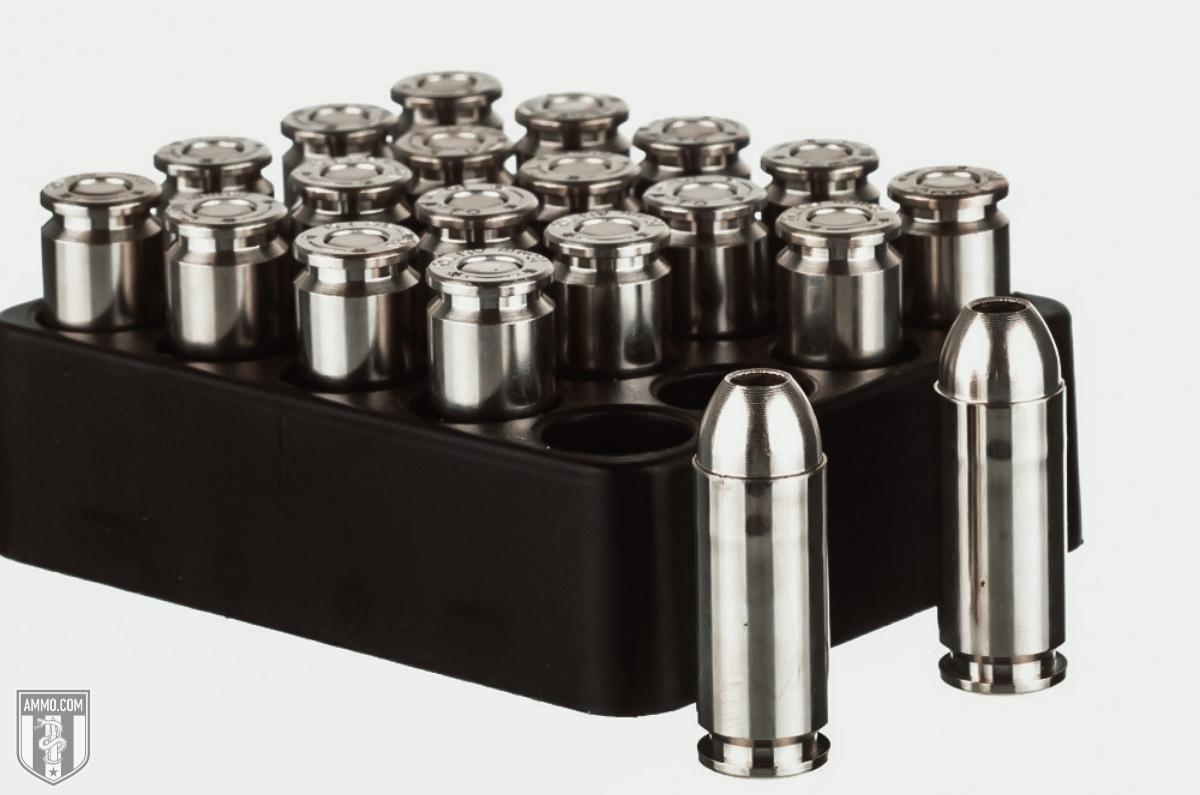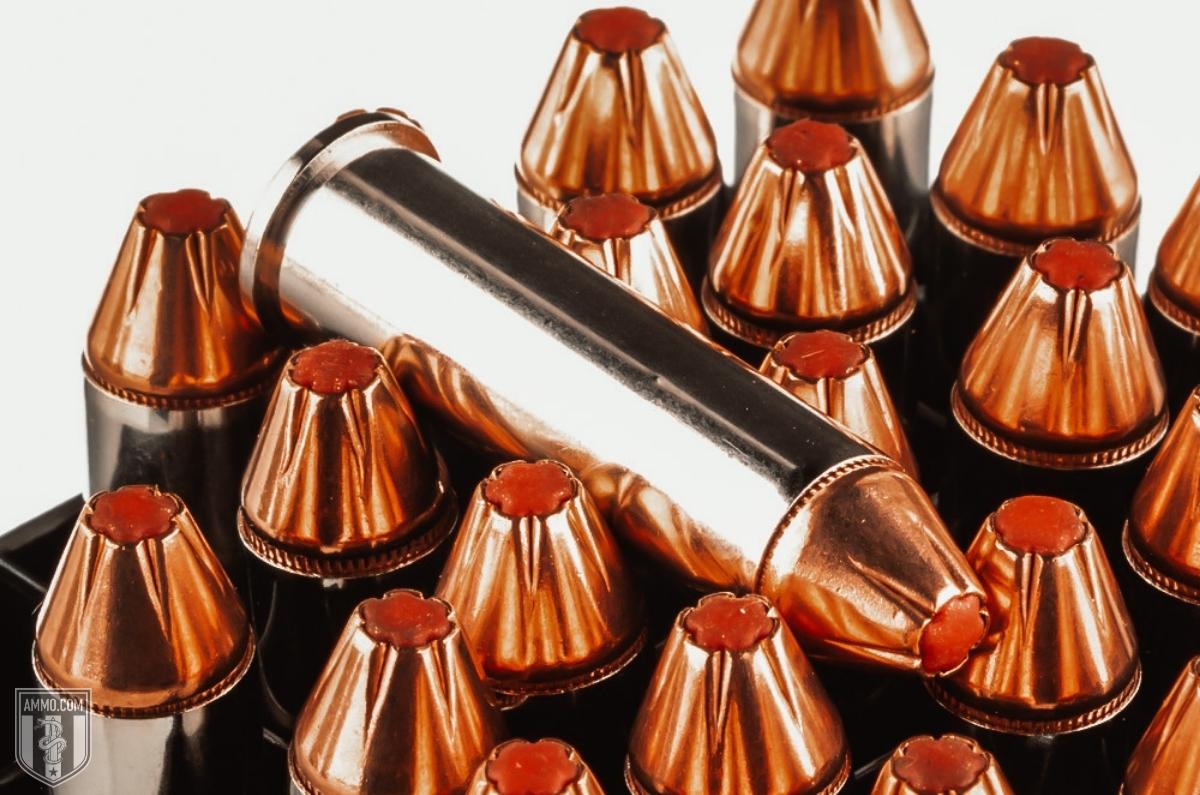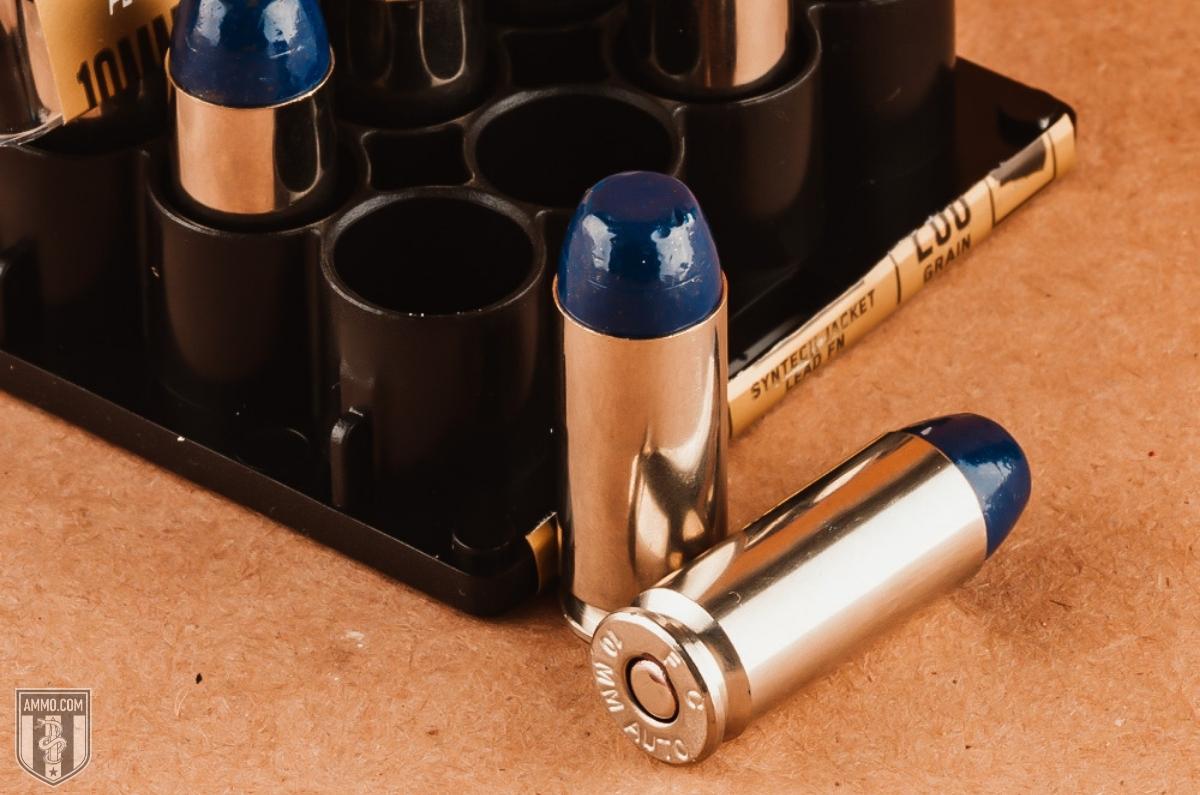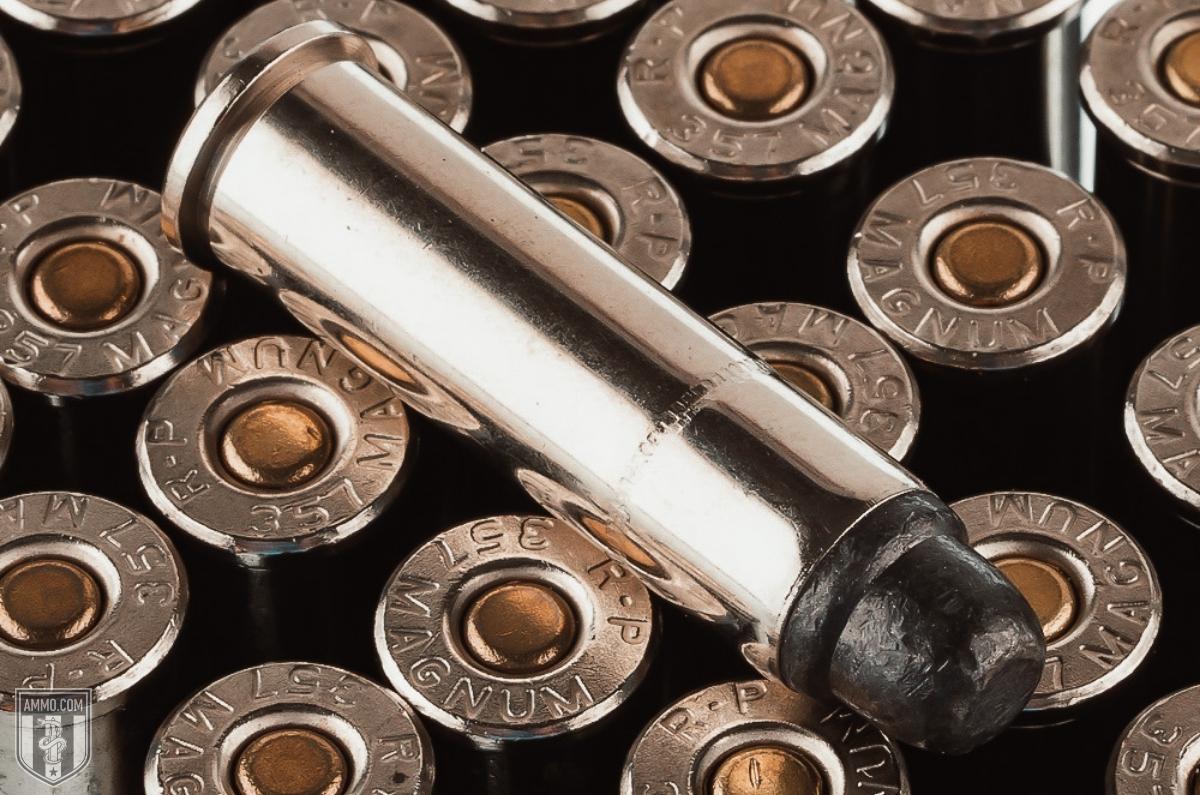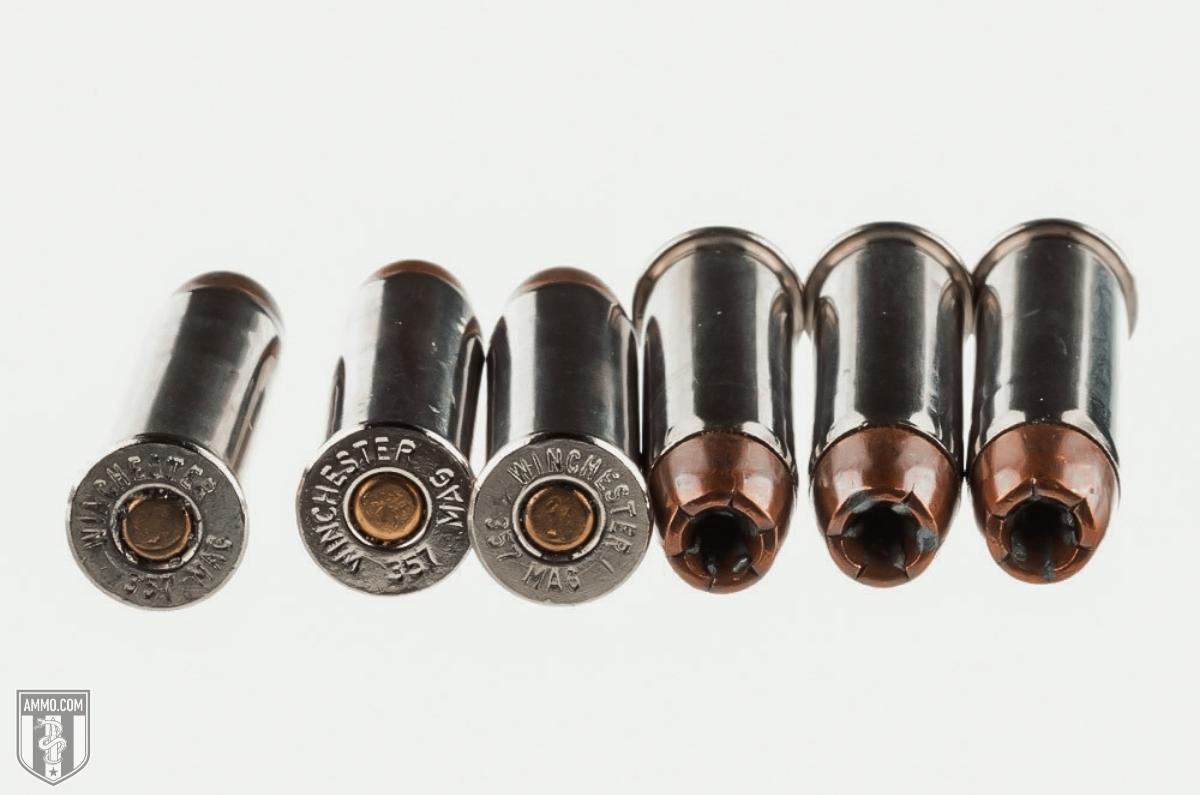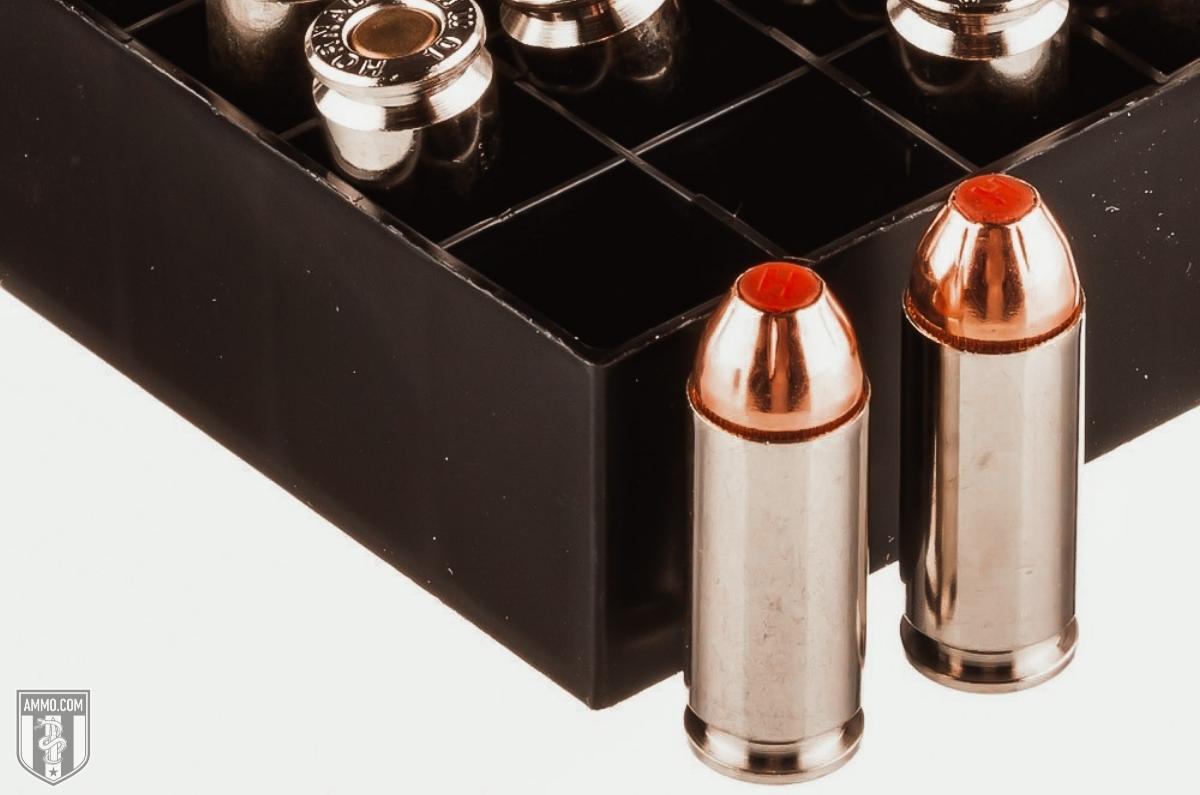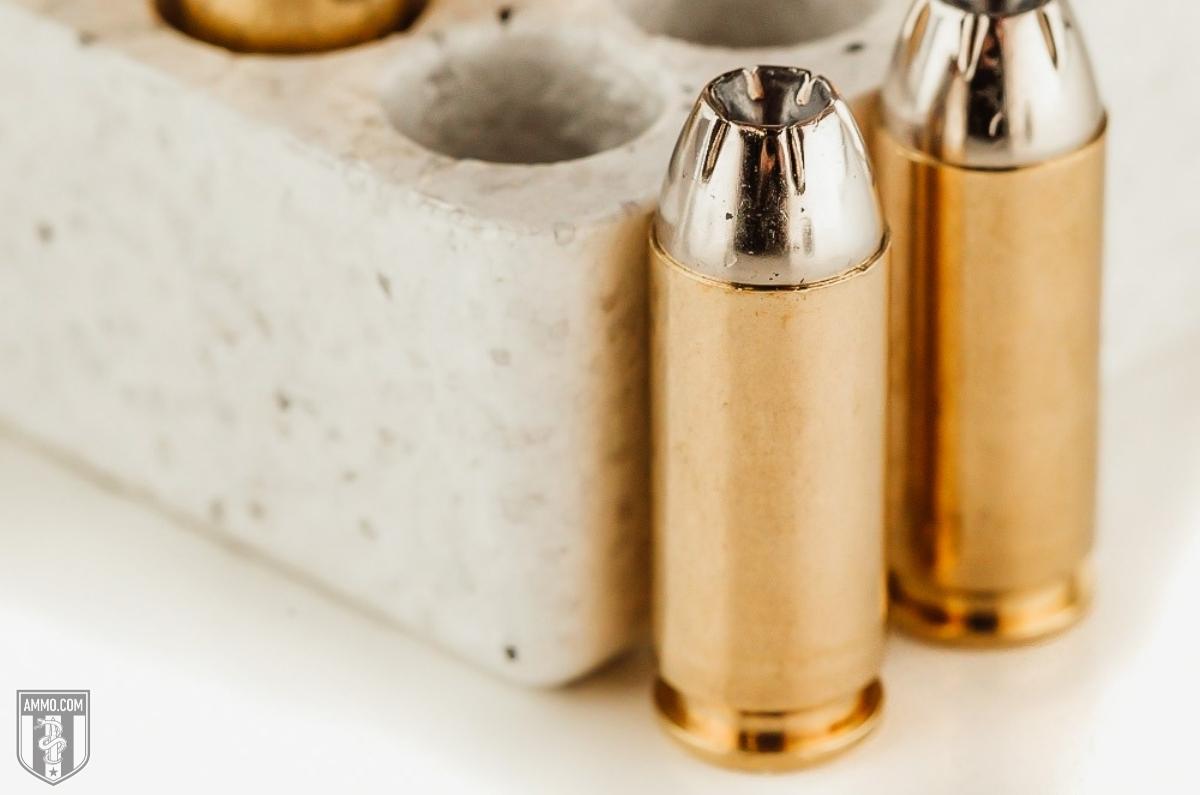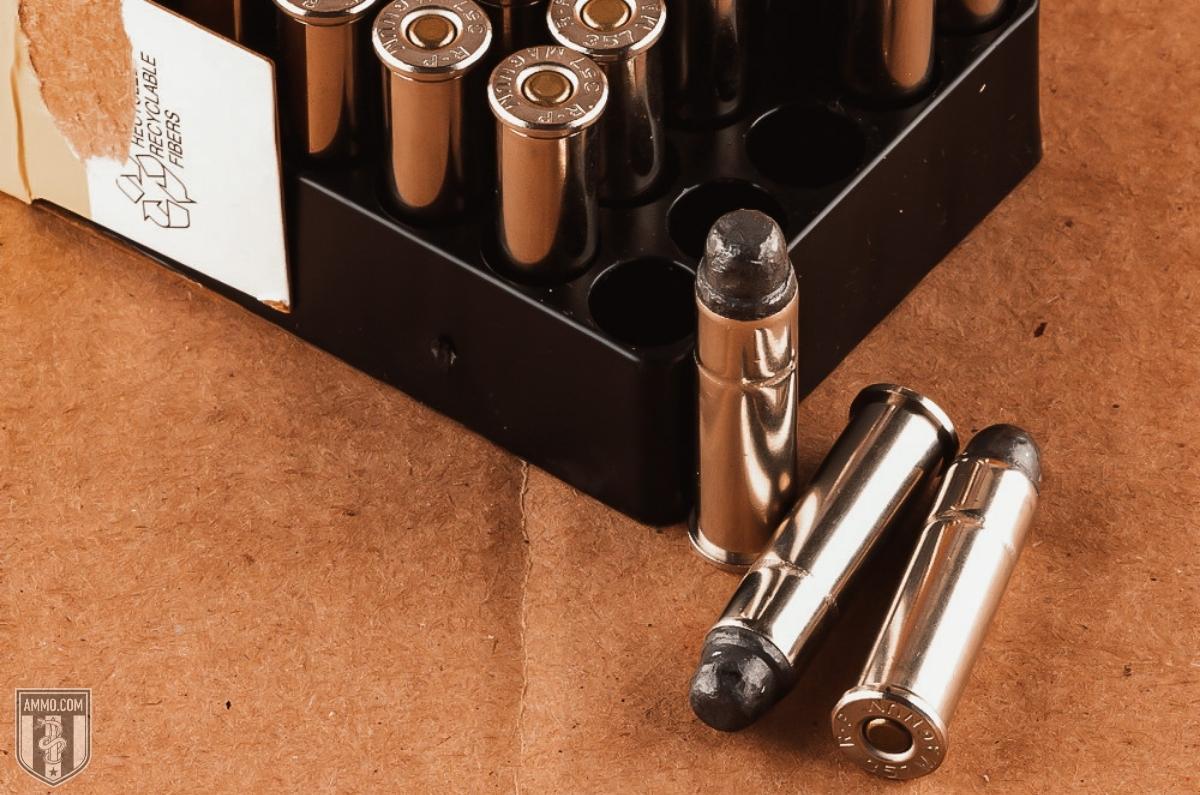10mm vs 357: Full Power Magnum Loads
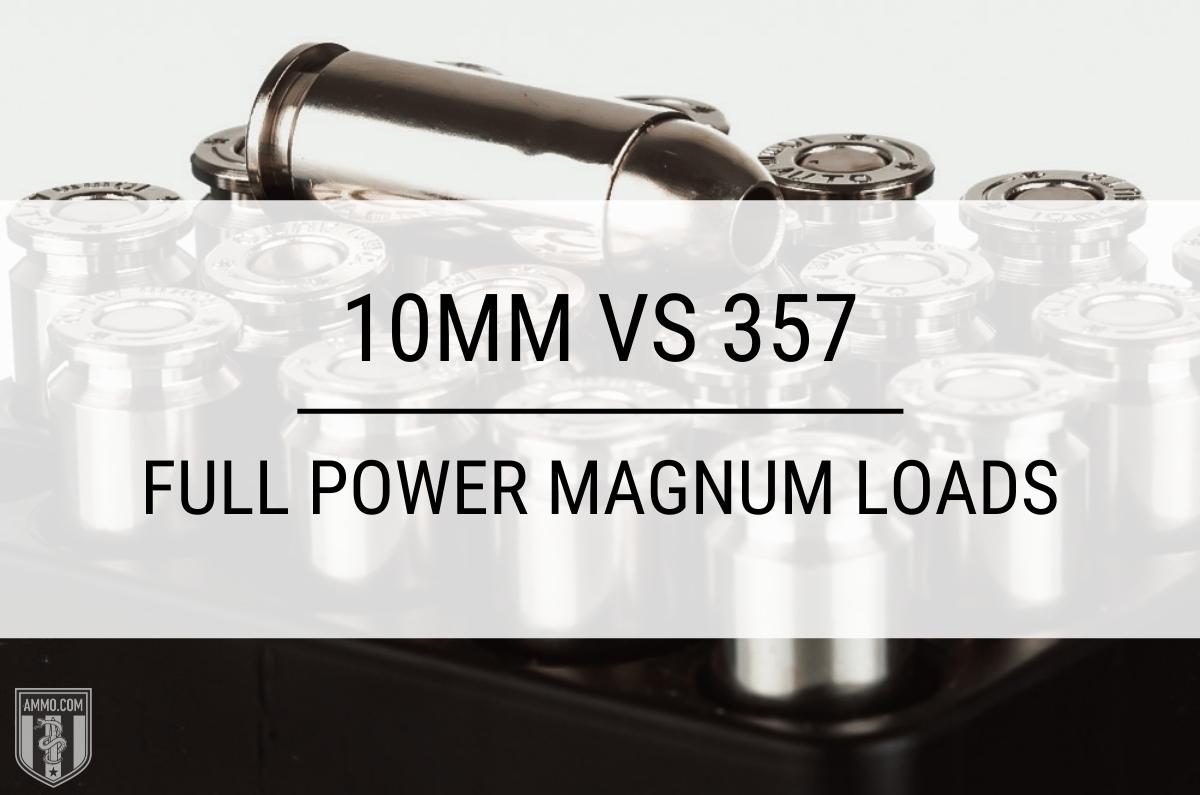 If your trigger finger gets that tingly sensation when you hear the words, “Magnum, full power, and strong recoil” then the 10mm Auto and 357 Magnum might be the right cartridges for your next handgun purchase.
If your trigger finger gets that tingly sensation when you hear the words, “Magnum, full power, and strong recoil” then the 10mm Auto and 357 Magnum might be the right cartridges for your next handgun purchase.
Both centerfire handgun cartridges understand what the term “magnum” means and really pack on the kinetic energy, muzzle velocity, and felt recoil.
Although both cartridges have similar ballistic performance, the comparison between 10mm vs 357 Mag truly comes down to the decision on which shooting platform works best for you: semi-auto or revolver?
This is a question that only you can answer. However, in this article we will dig deep into the advantages and disadvantages of the 357 and 10mm so that you can make the best choice for your next handgun purchase.
What’s The Difference Between 10mm vs 357?
The difference between 10mm vs 357 Magnum is that the 10mm was designed for use in semi-auto handguns while the 357 Mag was designed for use in revolvers. The 357 Mag fires a 0.357” diameter bullet while the 10mm Auto fires a 0.40” diameter bullet.
Cartridge Specs
When comparing two handgun cartridges, it’s a good practice to examine the differences in case design to gain more knowledge of each.
The first major difference to note is that the 357 Mag is a rimmed cartridge while the 10mm cartridge is rimless. This difference showcases the design intention for both cartridges as the 10mm was designed for use in a semi-automatic pistol while the 357 Magnum is primarily a revolver round.
The rim on a revolver round is used to headspace the cartridge in the cylinder, while a rim is not ideal in an autoloader due to the potential for rim lock. Rim lock (or “rimlock”) is a condition where a rimmed cartridge slips behind the rim of the cartridge following it in the magazine, causing a jam. This can happen if the cartridges are loaded incorrectly into the magazine, or it can occur during firing. This is the main reason why most semi-auto cartridges are rimless, like the 10mm Auto.
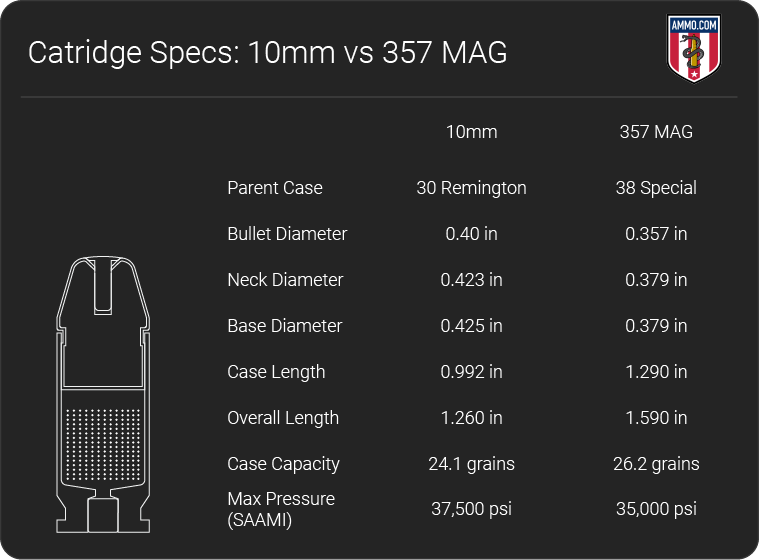
The second major difference is the bullets that the two cartridges fire. The 357 Magnum fires a 0.357” bullet diameter as the name implies, likewise the 10mm fires a 0.40” bullet diameter. This will mean that generally the 10mm will fire a larger, heavier bullet.
The case length for the 357 Mag is also considerably longer than the 10mm Auto case, which allows the 357 to have a slightly higher case capacity than the 10mm Auto.
Lastly, the 10mm is capable of handling higher pressures than the 357 based on SAAMI specs.
Stopping Power
Stopping power is one of those topics that can start an argument between shooters more heated than most political debates. You’ll hear statements thrown around like, “The 45 ACP has the most stopping power” or, “The 44 Magnum is the best round because it has so much stopping power.”
But the problem with making statements like these is that they are not backed by any sort of quantifiable data, only anecdotal evidence.
Since its introduction, the 125-grain jacketed hollowpoint (JHP) fired from a 357 Magnum has long been considered the gold standard when it comes to self-defense rounds. However, 10mm loads and the Glock 20 are the most popular round and semi-automatic pistol in Alaska for bear defense.
Does this mean that the 10mm is superior to the 357? Decidedly not.
FBI ballistic gel data from the 357 and 10mm show extremely impressive wound channels with standard defense rounds. There’s no doubt that both will serve you well in most all self-defense situations. What this means is that shot placement trumps any numbers on a ballistic table.
No amount of muzzle energy, FPS of velocity, or the fanciest hollowpoint ammo will make up for poor shot placement. However, a center mass hit to the vital organs or central nervous system from either a 357 or 10mm with a properly constructed JHP will be more than sufficient to stop any potential threat.
Therefore, it cannot be said that either round has more stopping power than the other.
However, this should not be confused with thinking that 357 Mag and 10mm are identical. On the contrary, both have their advantages and disadvantages that will be analyzed in the following sections.
Recoil
Recoil is an important consideration when purchasing a new self-defense handgun. A round with heavy recoil will be more difficult to control and will slow your rate of follow up shots.
Recoil is affected primarily by muzzle velocity (FPS) and bullet weight. The faster a bullet travels, the harder it pushes back on the shooter. Furthermore, a heavier bullet requires more force to push it out the barrel, which is returned to the shooter’s wrists.
The way recoil is felt varies from shooter to shooter. Some describe the 10mm as having a snappy recoil while others have no issue with it. The same can be said about 357.
Heavy recoil not only slows follow up shots, but it also can cause an inexperienced shooter to develop recoil anticipation and flinch right before the round is fired. Typically recoil anticipation will cause the shooter to dip the muzzle down before firing, sending shots low.
Handling recoil is a skill that can be learned with time, practice, and professional instruction, but it can be challenging for shooters who are sensitive to recoil. This is the main reason why the FBI moved away from the 10mm and developed the 40 S&W, the recoil of full power 10mm was too difficult to handle and agents were having trouble handling the powerful 10mm cartridge.
Make no mistake, both the 10mm and 357 Magnum are heavy recoiling pistol cartridges. They were designed to be extremely powerful, and the price for that is recoil.
Recoil will vary between types of ammo and loads. Practice ammo, like full metal jacket (FMJ) rounds, are often loaded with less powder to make for a more enjoyable shooting experience and to aid in shooters not developing a recoil flinch. However, defense ammo is typically loaded closer to full power and will have heavier recoil.
One other aspect that helps mitigate recoil is firearm weight. This is one of the main reasons why the full-size Glock 20 and Colt Delta Elite are so popular with 10mm shooters, the added weight helps make for a more controllable firearm.
With 357 Magnum revolvers, many shooters prefer K-frame and L-frame Smith & Wesson offerings as they are heavier and have longer barrel length.
Taking all of this into consideration, the question remains, “How much recoil do these magnum loads have?”
Over a sampling of loads, the 10mm Auto will have around 9 ft-lbs of felt recoil while the 357 Magnum will impart 10 ft-lbs of energy into the shooter’s wrists.
This is not a huge difference, and most shooters will not be able to discern the difference between the two cartridges. However, the 10mm Auto will generally have less recoil.
Velocity/Penetration
When it comes to muzzle velocity, there is a lot of overlap between different loads for 357 and 10mm.
However, the 357 Magnum will typically have a slight velocity advantage over the 10mm as the 357 can fire lighter bullets. You can find 357 Magnum loaded with a 110 grain bullet, screaming out of the muzzle at 1,295 FPS.
For the 10mm round, the most popular loads are 170 and 180 grains. As the 10mm has less case capacity than the 357, the 10mm will generally have lower muzzle velocity but only slightly.
In terms of penetration, both the 357 and 10mm perform extremely well in FBI ballistics gel testing. However, the 357 tends to over penetrate due to its increased muzzle velocity and lighter bullet weight. This is why it is so critical to carry high quality JHP defense ammo like Winchester PDX1, Hornady XTP, or Remington Golden Sabers to aid in stopping overpenetration.
The truth is that both rounds were developed for law enforcement who needed exceptional penetration to take on the threats of the era. Both the 10mm and 357 Mag will provide more than enough velocity and penetration to handle any self-defense situation.
Magazine Capacity
This is one category where the 10mm pistols dominate as a revolver cannot compete with a semi auto pistol in terms of magazine capacity.
Most 357 Magnum revolvers will have a capacity of 5 to 6 rounds. In contrast, a Glock 20 can carry a whopping 15 rounds while the subcompact Glock 29 can carry 10 rounds.
Although rimmed cartridges are less ideal for semi-auto fire, there are several options for 357 Mag in a semi-automatic offering. The two most prominent options being the Coonan .357 1911 and the Magnum Research Desert Eagle L5/L6.
The Coonan has a 7-round capacity while the Desert Eagle can carry 9 rounds of 357 Mag.
There’s just no comparison when a subcompact Glock 29 can carry more rounds than a full-sized Desert Eagle! The 10mm clearly dominates in terms of magazine capacity.
Hunting
The 357 Mag and 10mm have found their homes in the woods, but admittedly in different areas.
The 10mm cartridge and Glock 20 are the most popular semi-auto offerings sold in Alaska. The 10mm is a potent bear deterrent with its deep penetration and high muzzle velocity. Although I’d feel a bit better with a 44 Magnum, 454 Casull or 500 Smith & Wesson on my hip in bear country, 10mm pistols offer increased magazine capacity and fire rate to amp up your delivery speed of lead-based bear spray. The Buffalo Bore Outdoorsman 220 grain hard cast 10mm cartridge would work well for bear as it offers the extreme penetration needed to take on a bear.
Please note that Glock does not advise shooting lead bullets in their handguns due to their use of polygonal rifling in all their barrels. If you want to shoot lead bullets out of your Glock, it is recommended that you purchase a replacement barrel using traditional rifling to avoid any potential leading issues.
The 10mm Auto is also one of the few semi-auto cartridges approved for hunting whitetail deer in several states, however, know your local laws and hunting regulations before taking any firearm into the woods.
The 357 Magnum is no stranger to hunting as has been a whitetail staple in many states for handgun hunting. A lever action carbine chambered in 357 Magnum makes for a very light and maneuverable rifle in a deer stand or on a stalk. Federal 357 Magnum ammo has several options for deer cartridges. Their Fusion, Power-Shok, and HammerDown lines have been specifically formulated to be potent deer stopping rounds.
The 357 also has enough kinetic energy to be a potent bear deterrent using hard cast lead rounds from Buffalo Bore or full power loads from Underwood Ammo.
Both handgun cartridges will serve you well in the woods, however the 357 Mag is better suited for hunting as it offers considerably more versatility with its wide variety of bullet weights and host firearms to choose from.
Concealed Carry/Home Defense
When discussing the differences between 357 Magnum and 10mm Auto in terms of concealed carry and/or home defense, the argument rarely centers around stopping power. Both rounds are extremely powerful and leave devastating wound channels that are very effective at stopping a threat.
In the context of self-defense, this comparison comes down to whether you prefer a magnum revolver or a semi-automatic pistol.
For concealed carry, the semi-auto pistol is the clear winner due to magazine capacity. When you’re out in the world, the amount of ammo you can carry is all you’ve got. Furthermore, magazines are a lot easier to securely carry than extra moon clips or speed loaders.
A circular speed loader and their carry pouch is more difficult to conceal than an extra magazine as the speed loader pouches tend to print more. Conversely, firearm width is less of an issue, as many snub-nose revolvers are as thin or thinner than a 10mm subcompact like a Glock 29.
Reload speed is another aspect to consider, as it is considerably easier and faster to reload a semi-auto pistol compared to a revolver. This can be overcome with consistent training, but most shooters cannot reload a revolver as fast as Jerry Miculek.
A semi-auto handgun will allow you to carry more rounds and reload faster when precious seconds can mean the difference between life and death.
For home defense, firearm weight and width are less of an issue. You can easily store a full-size revolver or semi-auto with several extra magazines or speed loaders on your nightstand in a gun vault.
Both the 10mm and 357 are extremely potent self-defense cartridges with proven JHP ammo, and both will serve you well in any life-or-death situation. However, for many shooters, the increased magazine capacity and added speed of reloading are enough to make them pick the 10mm over the 357.
Ammo and Handgun Cost/Availability
In terms of ammo variety, the 357 Magnum reigns supreme as it has been on the market longer. However, 10mm wins in terms of ammo cost.
On average, standard full metal jacket (FMJ) practice ammo runs around $1/round for 10mm and around $1.20/round for 357. It’s not a huge difference, but 10mm ammo is less expensive. For personal defense rounds, cost per round will vary based on manufacturer and bullet design. However, you should expect to pay nothing less than $2/round for quality JHP ammo in either caliber.
Speaking of price make sure to check out our stock of Hornady 357 Magnum ammo for more options.
As far as handgun availability is concerned, the 357 Mag wins by a large margin for the same reason as ammo variety. The 357 has simply been on the market longer and all revolver manufacturers like Smith & Wesson, Ruger, Rossi, and Taurus will have some offering in 357.
In comparison, the 10mm was nearly lost in the annals of firearm history after the FBI dropped the round in favor if the 40 S&W. However, the 10mm was saved by the introduction of the Colt Delta Elite 1911 and the Glock 20.
Now, more and more manufacturers like Kimber, Sig Sauer, and Springfield are offering semi-auto handguns chambered in 10mm. However, the 10mm cannot compete with the popularity of the 357 at this time.
Cost for both firearms will be comparable. Most offerings in both calibers will start off around the $550 mark and go up from there. High-end revolvers like the Smith & Wesson Performance Center line will command a considerably higher price than an entry model, but then a Dan Wesson 1911 chambered in 10mm will punch a hole in your wallet similarly sized to the 180 grain JHP ammo it can fire.
Neither caliber commands a significant advantage in terms of price, but the 357 does separate itself from the 10mm in terms of variety of handguns on the market.
Reloading
If you enjoy reloading, then the 357 Magnum and 10mm Auto will be wonderful additions to your reloading bench. Both 0.357” and 0.40” diameter bullets are extremely popular and easy to find.
Furthermore, there is a wide variety of reloading data available to select the perfect powder for your ideal handload.
Reloading is a great way to increase the consistency of your ammo as well as reducing your overall cost per round. Reloaders have been working on the ideal load for 357 for decades and reloaders of the 10mm enjoy customizing their ammo for an enjoyable shooting experience.
All of the major bullet manufacturers like Hornady, Barnes, Nosler, and Sierra produce a wide variety of bullets to create your perfect handload for your handgun.
Don't forget too check out our stock of Hornady 375 H&H ammo.
The sky is the limit when it comes to reloading 10mm and 357 Mag!
Ballistics
Our team here at Ammo.com has spent countless hours scouring the Internet to bring you extremely comprehensive ballistics tables for both calibers. These tables will compare bullet weight to muzzle velocity, kinetic energy, and trajectory.
10mm Ballistics: Chart of Average 10mm Ballistics
Note: This information comes from the manufacturer and is for informational purposes only. The actual ballistics obtained with your firearm can vary considerably from the advertised ballistics. Also, ballistics can vary from lot to lot with the same brand and type load.
| 10mm Bullet WEIGHT | Muzzle VELOCITY (fps) | Muzzle ENERGY (ft. lbs.) | Mid-Range TRAJECTORY (in.) | Barrel Length (in.) | |||||
|---|---|---|---|---|---|---|---|---|---|
| Muzzle | 50 yds. | 100 yds. | Muzzle | 50 yds. | 100 yds. | 50 yds. | 100 yds. | ||
| 155 Grain | 1125 | 1046 | 986 | 436 | 377 | 335 | 0.9 | 3.9 | 5" |
| 155 Grain | 1265 | 1118 | 1018 | 551 | 430 | 357 | n/a | n/a | 5" |
| 170 Grain | 1340 | 1165 | 1145 | 680 | 510 | 415 | 0.7 | 3.2 | 5" |
| 175 Grain | 1290 | 1140 | 1035 | 650 | 505 | 420 | 0.7 | 3.3 | 5.5" |
| 180 Grain FBI | 950 | 905 | 865 | 361 | 327 | 299 | 1.5 | 5.4 | 4" |
| 180 Grain | 1030 | 970 | 920 | 425 | 375 | 340 | 1.1 | 4.7 | 5" |
| 180 Grain HV | 1240 | 1124 | 1037 | 618 | 504 | 430 | 0.8 | 3.4 | 5" |
| 200 Grain | 1160 | 1070 | 1010 | 495 | 510 | 430 | 0.9 | 3.8 | 5" |
357 Magnum Ballistics: Chart of Average 357 Magnum Ballistics
Note: This information comes from the manufacturer and is for informational purposes only. The actual ballistics obtained with your firearm can vary considerably from the advertised ballistics. Also, ballistics can vary from lot to lot with the same brand and type load.
| 357 Magnum Bullet WEIGHT | Muzzle VELOCITY (fps) | Muzzle ENERGY (ft. lbs.) | Mid-Range TRAJECTORY (in.) | Barrel Length (in.) | |||||
|---|---|---|---|---|---|---|---|---|---|
| Muzzle | 50 yds. | 100 yds. | Muzzle | 50 yds. | 100 yds. | 50 yds. | 100 yds. | ||
| 105 Grain | 1650 | n/a | n/a | n/a | 385 | n/a | n/a | n/a | n/a |
| 110 Grain | 1295 |
1095 | 975 | 410 | 290 | 230 | 0.8 | 3.5 | 4-V |
| 125 Grain Medium Velocity | 1220 | 1075 | 985 | 415 | 315 | 270 | 0.8 | 3.7 | 4-V |
| 125 Grain JHP | 1409 | n/a | n/a | 551 | n/a | n/a | n/a | n/a | n/a |
| 125 Grain | 1450 | 1240 | 1090 | 585 | 425 | 330 | 0.6 | 2.8 | 4-V |
| 125 Grain | 1500 | 1312 | 1163 | 624 | 478 | 376 | n/a | n/a | 8" |
| 125 Grain JHP | 1600 | n/a | n/a | 771 | n/a | n/a | n/a | n/a | n/a |
| 140 Grain Multi-Ball | 1155 | 830 | 665 | 420 | 215 | 135 | 1.2 | 6.4 | 4-V |
| 140 Grain | 1360 | 1195 | 1075 | 575 | 445 | 360 | 0.7 | 3 | 4-V |
| 140 Grain FlexTip | 1440 | 1274 | 1143 | 644 | 504 | 406 | n/a | n/a | n/a |
| 145 Grain | 1290 | 1155 | 1060 | 535 | 430 | 360 | 0.8 | 3.5 | 4-V |
| 150 Grain | 1235 | 1105 | 1015 | 535 | 430 | 360 | 0.8 | 3.5 | 4-V |
| 158 Grain | 1235 | 1105 | 1015 | 535 | 430 | 360 | 0.8 | 3.5 | 4-V |
| 158 Grain Cowboy | 800 | 761 | 725 | 225 | 203 | 185 | n/a | n/a | n/a |
| 158 Grain JHP | 1350 | n/a | n/a | 640 | n/a | n/a | n/a | n/a | n/a |
| 158 Grain Remington Maximum | 1825 | 1590 | 1380 | 1170 | 885 | 670 | 0.4 | 1.7 | 10.5" |
| 165 Grain | 1290 | 1189 | 1108 | 610 | 518 | 450 | 0.7 | 3.1 | 8-3/8" |
| 180 Grain | 1145 | 1055 | 985 | 525 | 445 | 390 | 0.9 | 3.9 | 4-V |
| 180 Grain | 1180 | 1088 | 1020 | 557 | 473 | 416 | 0.8 | 3.6 | 8-V |
| 180 Grain CorBon F.A. | 1650 | 1512 | 1386 | 1088 | 913 | 767 | 1.66 | 0 | n/a |
| 200 Grain | 1200 | 1123 | 1061 | 640 | 560 | 500 | 3.19 | 0 | n/a |
10mm Development and History
The 10mm Auto cartridge was initially developed by Unsung American Hero Lieutenant Colonel Jeff Cooper. Cooper designed the 10mm to have better external ballistics (muzzle velocity, effective range) than the 45 ACP and better terminal ballistics (expansion, penetration) than the 9mm Luger.
In 1983, Norma Precision improved upon Jeff Cooper’s design by increasing its power to be marketed in Dornaus & Dixon Enterprises’ new handgun, the Bren Ten. The new 10mm Auto cartridge submitted by Norma was derived from the .30 Remington rifle round and had an extremely flat trajectory and high muzzle energy on par with the 357 Magnum in some loadings.
Although the Bren Ten handgun was doomed to failure due to an extremely high price tag, production delays, and eventual bankruptcy of Dornaus & Dixon, the 10mm Auto was saved by Colt and their release of the Delta Elite (a M1911 chambered in 10mm) in 1987. Furthermore, the FBI adopted the 10mm Auto as their new service handgun cartridge in response to the 1986 Miami Shootout.
Although the 10mm was replaced by the 40 S&W for law enforcement use, the 10mm Auto cartridge has recently been gaining in popularity and more firearms manufacturers are offering handguns chambered in 10mm.
If you’d like to learn more about how the 10mm compares to other calibers, check out our article on 10mm Auto vs 9mm Luger.
357 Magnum Development and History
Regarded as the Father of the Modern Magnum, Elmer Keith is credited with the development of the 357 Magnum, and later the 44 Magnum and the 41 Magnum.
Keith, in conjunction with Phillip Sharpe, worked on increasing the power of the 38 Special by dosing it with a bit more powder. To accommodate the increased powder charge, the 38 Special case was elongated by about 0.15”, preventing a 357 Magnum round from chambering in a 38 Special revolver.
Keith designed the round to fire a 0.357” diameter bullet at 1450 FPS out of a 4 inch barrel. The resulting cartridge was submitted to Smith and Wesson in 1934, and thus the 357 Magnum was born.
The new cartridge was primarily marketed to law enforcement who needed a more powerful handgun round to combat bootleggers and the mafia. Criminals of the Prohibition Era were wearing early ballistic vests and using cars for cover, and although the 38 Special was ineffective against these defenses, the 357 Magnum was more than up to the task.
Since its adoption, the 125 grain JHP 357 Magnum round has been considered the gold standard for personal defense cartridges. It is so effective that many ammo manufacturers have tried to replicate the terminal ballistics of the cartridge, the 357 SIG being the most notable of the bunch.
Don't forget to check out our Remington 357 Magnum ammo and Fiocchi 357 Magnum ammo page for affordable ammo options.
Regardless of your feelings towards revolvers, the 357 Magnum is a cartridge that should not be underestimated in its defensive capabilities.
If you’d like to learn more about how the 357 Mag compares to other calibers, check out our 357 Magnum vs 38 Special caliber comparison.
Final Shots: 10mm vs 357 Mag
If you’re in the market for a defensive round that can really pack on the foot-pounds and FPS, then look no further than the 357 Magnum and 10mm Auto.
Since its introduction in the 1930’s, the 357 Magnum round has proven itself to be a capable defensive option for concealed carry and home defense. With blistering muzzle velocity and kinetic energy, the 357 truly epitomizes what a magnum round should be.
The 10mm Auto was developed to bridge the gap between 9mm and 45 ACP, and it does so by closely mimicking the external and internal ballistics of the 357 Mag. Although the 10mm comes up a little short on foot-pounds and FPS when compared to the 357, it makes up any shortcomings by offering the shooter a semi-auto platform that allows for lightning fast reloads and double the magazine capacity of a 6-shot revolver.
The one drawback of both cartridges is heavy recoil. This problem is exacerbated when 10mm and 357 are used in handguns popular for concealed carry, namely lightweight subcompacts like the Glock 29 or a snub nose revolver.
Determining which handgun cartridge is right for you is an exercise in understanding which shooting platform you like best.
If you prefer semi-automatic pistols, then the 10mm is the obvious choice. If wheel guns are your bag, then it’s time to grab a 357 Magnum.
You cannot go wrong with either choice and will never feel under-gunned when you step out of your home with your 10mm or 357 Magnum handgun securely holstered on your hip.
Ammo Comparisons
- .308 vs 5.56
- 6.5 Creedmoor vs .308
- .300 Blackout vs .308
- .300 Win Mag vs .308
- .243 vs .308
- .308 vs .30-06
- 7mm-08 vs .308
- .270 vs .308
- 7.62x39 vs .308
- .223 vs .308
- .338 Lapua vs .308
- .380 ACP vs 9mm
- .223 vs 5.56
- .300 Blackout vs 5.56
- 9mm vs 45 ACP
- 9mm vs 40 S&W
- .357 SIG vs 9mm
- 10mm vs 9mm
- 9mm vs 9mm Luger
- .243 vs .270
- .300 Win Mag vs .30-06
- .270 vs .30-06
- .40 vs .45
- 38 Special vs 357
- 9mm vs 40 vs 45
- 5.56 vs 7.62x39
- 338 Lapua vs .30-06
- .30-30 vs .30-06
- 300 PRC vs 338 Lapua
- .30-06 vs 7mm
- 300 Win Mag vs 338 Lapua
- 300 PRC vs 300 Win Mag
- 300 WSM vs 300 Win Mag
- 338 Win Mag vs 338 Lapua
- 12 Gauge vs 20 Gauge
- 10mm vs 357 Mag
- .30-30 vs 7.62x39
- 224 Valkyrie vs 22-250
- 17 HMR vs 22 Mag
- 7.62x39 vs .300 Blackout
- 45 ACP vs 45 Auto
- 45-70 vs 30-30
- 300 Blackout vs 223
- 357 Magnum vs 9mm
- 350 Legend vs 300 Blackout
- 224 Valkyrie vs 223
- 45 ACP vs 38 Super
- 6.5 Grendel vs .308
- 17 HMR vs 22 LR
- 10 Gauge vs 12 Gauge
- 22-250 vs 223
- 45 Colt vs 45 ACP
- 350 Legend vs 30-30
- 5.7x28 vs 223
- 5.7 vs 9mm
- 5.56 vs 5.7
- 22 vs 9mm
- Buckshot vs Birdshot
- 450 Bushmaster vs 308
- 450 Bushmaster vs 223
- Buckshot vs Slug
- 6.5 Grendel vs 5.56 vs 223
- 6mm ARC vs 6.5 Grendel
- 44 vs 45
- 458 SOCOM vs 5.56
- 357 vs 44
- 32 ACP vs 380
- 300 Win Mag vs 338 Win Mag vs 338 Lapua Mag
- 450 Bushmaster vs 458 SOCOM vs 50 Beowulf
- 6mm Creedmoor vs 6.5 Creedmoor
- TMJ vs FMJ
- 44 Special Vs 44 Magnum
- 45 90 vs 45 70
- 6.8 Western vs 6.8 SPC
- 50 Beowulf vs 50 BMG
- 26 Nosler vs 6.5 PRC
- 28 Gauge vs 410
- 6.8 SPC vs 5.56
- 6.8 SPC vs 6.5 Grendel
- 6.8 Western vs 7mm Rem Mag vs .28 Nosler
- 6.8 Western vs 6.5 Creedmoor
- 22 Hornet vs 223
- 6.8 Western vs 6.5 PRC
- .410 vs 12 Gauge
- .410 vs 20 Gauge
- 22 LR vs 22 Mag
- 6mm ARC vs 243
- 7mm-08 vs 270
- 243 vs 6.5 Creedmoor
- Nickel vs Brass Casing
- 204 Ruger vs 223
- 50 Beowulf vs 5.56
- 260 Remington vs 6.5 Creedmoor
- 6mm Remington vs 243
- 28 Nosler vs 300 PRC
- 50 Beowulf vs 50 AE
- 22 Nosler vs 22-250
- 450 Marlin vs 45-70
- 300 Win Mag vs 300 Norma
- 458 SOCOM vs 300 Blackout
- 38-55 vs 45-70
- 22 Hornet vs 22 LR
- 300 Norma vs 338 Lapua
- 338 Lapua vs 50 BMG
- 28 Nosler vs 300 Win Mag
- 28 Nosler vs 6.5 Creedmoor
- 204 vs 22-250
- 458 SOCOM vs 45 70
- 44 40 vs 45 70
- 6.8 SPC vs 6.5 Creedmoor
- 450 Bushmaster vs 30-06
- 7mm Rem Mag vs 300 Win Mag
- 30 Carbine vs 223
- 25-06 vs 30-06
- 26 Nosler vs 28 Nosler
- 16ga vs 12ga
- 30 06 vs 7.62 x54R
- 9mm Makarov vs 9mm Luger
- 350 Legend vs 223
- 30 Carbine vs 5.56
- 6.5x55 vs 6.5 Creedmoor
- 6.5 Creedmoor vs 270 vs 25-06
- M193 vs M855
- 450 Bushmaster vs 458 SOCOM
- 6.5 Grendel vs 6.5 Creedmoor
- 350 Legend vs 5.56
- .277 Fury vs 6.8 SPC
- 277 Fury vs 300 Win Mag
- 10mm vs .45 ACP
- 277 Fury vs 223
- 6.8 SPC vs 300 Blackout
- 6.5 PRC vs 6.5 Creedmoor
- 277 Fury vs 308
- 277 Fury vs 6.5 Creedmoor
- 350 Legend vs 450 Bushmaster
- 277 Fury Vs 5.56 NATO
- 10mm vs 40S&W
- 32 ACP vs 9mm
- 32 Special vs 9mm
- 8.6 Blackout vs 300 Blackout
- 30 Super Carry vs. 9mm
- 5.56 vs 9mm
- .50 Action Express vs 9mm
- 7.62x25 vs. 9mm
- 10mm vs 44 Magnum
- 300 Blackout vs 300 Win Mag
- 6.5 Grendel vs 300 Blackout
- 460 Rowland vs 10mm
- 300 RUM vs 300 PRC
- 300 Norma vs 300 PRC
- 45 GAP vs 45 ACP
- 7mm PRC vs 300 Win Mag
- 300 PRC vs 6.5 Creedmoor
- 300 PRC vs 308
- 357 SIG vs 357 Mag
- 7.62x39 vs 7.62x51
- 243 Win vs 223 Rem
- 30 Nosler vs 300 PRC
